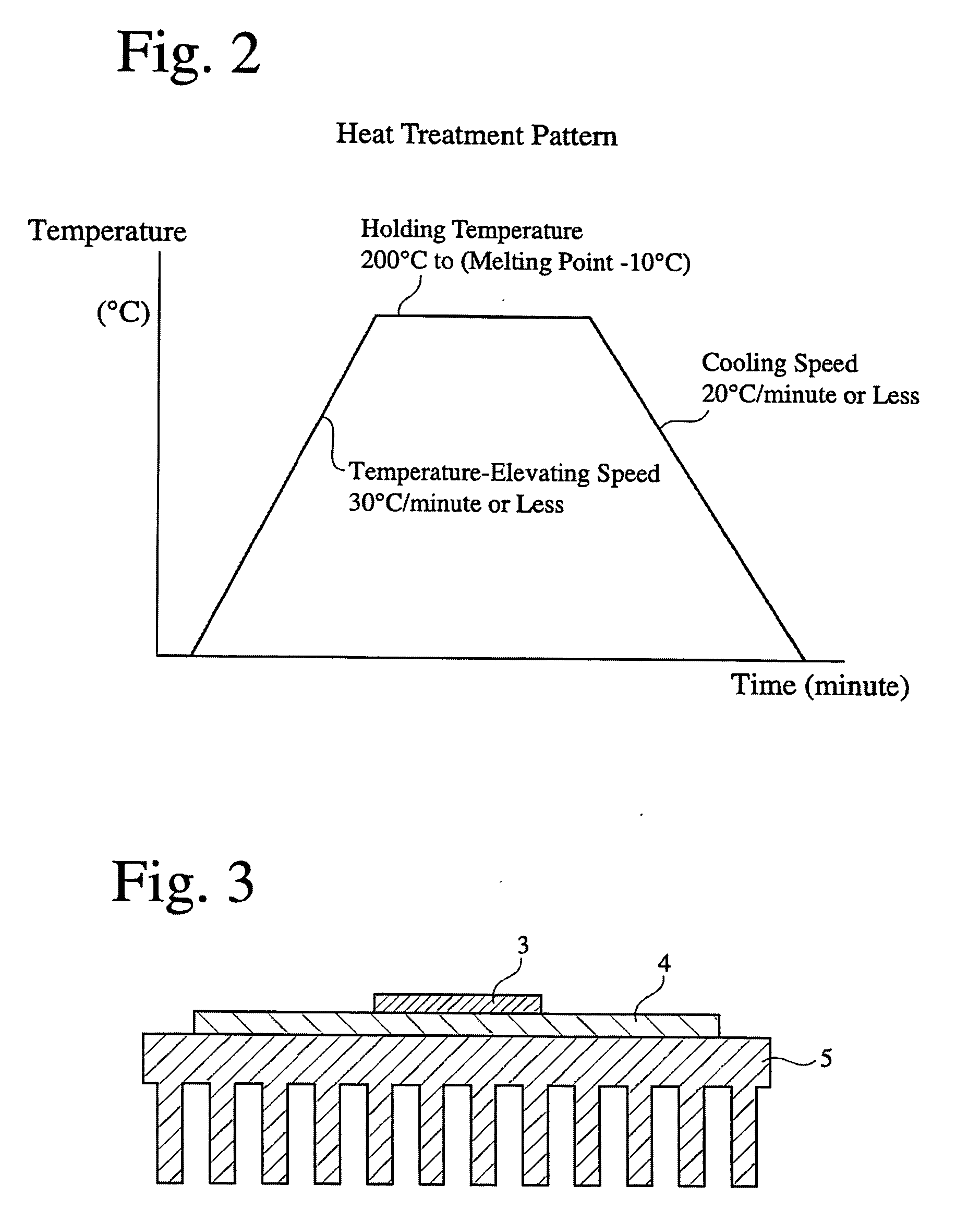Composite material having high thermal conductivity and low thermal expansion coefficient, and heat-dissipating substrate, and their production methods
- Summary
- Abstract
- Description
- Claims
- Application Information
AI Technical Summary
Benefits of technology
Problems solved by technology
Method used
Image
Examples
example 2
[0131] Using the same porous graphitized extrudate as in Example 1 and pure copper (purity 99.9% or more), a graphite / copper composite material was produced as follows. After a melt (1350.degree. C.) of the above pure copper poured into a cavity of the die apparatus (held at 1000.degree. C.) shown in FIG. 1(a), in which the above porous graphitized extrudate was placed, an upper punch was lowered to conduct melt-forging at 100 MPa for 5 minutes. Excess pure copper was cut away to obtain the graphite / copper composite material. This graphite / copper composite material was subjected to a heat treatment under the following conditions.
9 Temperature-elevating speed: 5.degree. C. / minute, Holding conditions: 900.degree. C. .times. 120 minutes, and Cooling speed: 5.degree. C. / minute.
[0132] The graphite / copper composite material after the heat treatment was cut to a size of 40.0 mm.times.20.0 mm.times.2.0 mm to provide a heat-dissipating substrate sample. The thickness direction of the heat-di...
example 3
[0137] Using the same porous graphitized extrudate as in Example 1 having a specific bulk density of 1.70, an ash content of 0.3% by mass, resistivity of 5.0 .mu..OMEGA.m and 8.5 .mu..OMEGA.m, respectively, in an extrusion direction and in the direction perpendicular to the extrusion direction, a thermal expansion coefficient of 0.6.times.10.sup.-6 / K and 2.0.times.10.sup.-6 / K, respectively, in an extrusion direction and in the direction perpendicular to the extrusion direction, and a thermal conductivity of 230 W / mK and 120 W / mK, respectively, in an extrusion direction and in the direction perpendicular to the extrusion direction, and brass comprising 70% by mass of Cu and 30% by mass of Zn, a graphite / brass composite material was produced under the following conditions.
[0138] After a melt (1350.degree. C.) of the above brass was poured into a cavity of the die apparatus (held at 1000.degree. C.) shown in FIG. 1(a), in which the above graphite was placed, an upper punch was lowered ...
example 4
[0142] A heat-dissipating substrate of 40.0 mm.times.20.0 mm.times.2.0 mm cut out from the graphite / Al--Si alloy composite material (after the heat treatment) of Example 1 shown in Table 6 was subjected to electroless Ni--P plating after a zincate treatment. A heat-dissipating substrate of 40.0 mm.times.20.0 mm.times.2.0 mm cut out from the graphite / Cu composite material (after the heat treatment) of Example 2 shown in Table 7 was also subjected to electroless Ni--B plating. To evaluate the correlation of the presence of a plating layer and sealability, the amount of a helium gas passing through each plated heat-dissipating substrate was measured by a helium leak detector DLMS-33 available from ULVAC, Inc. according to JIS C 7021 A-6. The amount of a helium gas passing through the plated heat-dissipating substrate, as the amount of a leaked helium gas, was used as a parameter of sealability. The results are shown in Table 9 below.
14TABLE 9 Amount of Leaked Type of Thickness Helium G...
PUM
| Property | Measurement | Unit |
|---|---|---|
| Fraction | aaaaa | aaaaa |
| Fraction | aaaaa | aaaaa |
| Linear density | aaaaa | aaaaa |
Abstract
Description
Claims
Application Information
 Login to View More
Login to View More - R&D
- Intellectual Property
- Life Sciences
- Materials
- Tech Scout
- Unparalleled Data Quality
- Higher Quality Content
- 60% Fewer Hallucinations
Browse by: Latest US Patents, China's latest patents, Technical Efficacy Thesaurus, Application Domain, Technology Topic, Popular Technical Reports.
© 2025 PatSnap. All rights reserved.Legal|Privacy policy|Modern Slavery Act Transparency Statement|Sitemap|About US| Contact US: help@patsnap.com



